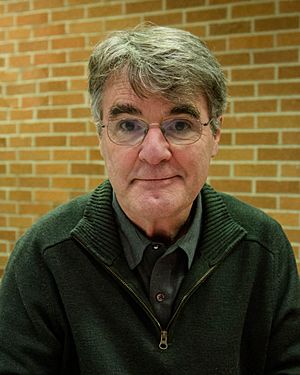David Macaulay facts for kids
Quick facts for kids
David Macaulay
|
|
|---|---|

Macaulay at the University of Findlay's Mazza Museum, November 2012
|
|
| Born | December 2, 1946 Burton upon Trent, Staffordshire, England |
| Occupation | Illustrator, writer |
| Education | Rhode Island School of Design (B.A.) |
| Genre | Picture books |
| Subject | Architecture, engineering, history |
| Notable works | |
| Notable awards |
|
David Macaulay (born December 2, 1946) is a famous British-American illustrator and writer. He is known for his detailed books that explain how things work. His books often combine text with amazing drawings.
Macaulay's works cover topics like architecture, design, and engineering. He has also written many children's fiction books. Some of his most famous books include Cathedral (1973) and The Way Things Work (1988). The Way Things Work book has been updated several times.
In 2006, Macaulay received a special award called the MacArthur Fellows Program award. He also won the Caldecott Medal in 1991 for his book Black and White.
Contents
Early Life and Education
David Macaulay was born in Burton upon Trent, England. He grew up in Lancashire, England. When he was eleven, his family moved to Bloomfield, New Jersey, in the United States.
From a young age, David loved to figure out how machines worked. He would build models and draw pictures of them. After high school, he went to the Rhode Island School of Design (RISD). He studied architecture there and earned a bachelor's degree.
Even though he studied architecture, David decided not to become an architect. He spent a year studying in Rome. Later, he worked as an interior designer and a teacher. Eventually, he started creating his own books.
David Macaulay's Books
David Macaulay has written many books about architecture and design. His first book, Cathedral (1973), showed how a large Gothic cathedral was built. He filled the book with detailed pen-and-ink drawings.
Books About Building Things
After Cathedral, he created more books like it:
- City (1974): This book showed how an ancient Roman city was built.
- Pyramid (1975): This book explained how the ancient Egyptian pyramids were constructed.
- Castle (1977): This book detailed the building of a medieval castle.
- Mill (1983): This book explored how mills in New England were built over time.
- Mosque (2003): This book showed the design and building of an Ottoman-style mosque. Macaulay created Mosque to show how major religions share many traditions.
Some of these books, like Cathedral and Castle, were later made into TV documentaries. These shows aired on PBS from 1983 to 1994.
Books About How Things Work
Macaulay also wrote Underground (1976). This book showed the pipes and structures hidden beneath a city street. Another book, Unbuilding (1980), imagined taking apart the Empire State Building.
One of his most popular books is The Way Things Work (1988). This book explains how many different machines and inventions operate. It has been updated several times, including The New Way Things Work (1998) and The Way Things Work Now (2016). The Way Things Work even became a short-lived educational TV show.
Macaulay's books often have a funny side. In The Way Things Work, he drew cave people and woolly mammoths using giant versions of machines. His book Motel of the Mysteries (1979) is a funny story. It's about future archaeologists who find an old American motel. They try to figure out what it was used for.
David Macaulay believes that people often don't understand how technology works. He tries to help people understand these things through his books.
Research for His Books
For his book The Way We Work, Macaulay spent years learning about the human body. He talked to doctors and researchers. He even watched medical procedures. He worked with experts to make sure his drawings and words were correct.
Other Creative Works
David Macaulay also designed a large mural in Providence, Rhode Island. It was painted on a wall next to Interstate 95. The mural showed statues of famous Rhode Island people. It also featured an energetic dog chasing a pigeon. The mural was on display from 2013 to 2017.
He has also worked with scientists at Harvard University. He created illustrations to help explain quantum materials. These drawings help both scientists and the public understand complex ideas.
Awards and Recognition
David Macaulay has received many awards for his work:
- MacArthur Fellows Program award (2006)
- Caldecott Medal for Black and White
- Boston Globe–Horn Book Award
- Christopher Award
- American Institute of Architects Medal
- Washington Children's Book Guild Nonfiction Award
- Deutscher Jugendliteraturpreis (a German youth literature prize)
- Dutch Silver Slate Pencil Award
- Bradford Washburn Award from the Museum of Science in Boston
He was also nominated for the international Hans Christian Andersen Award in 1984 and 2002. In 2008, he gave the important May Hill Arbuthnot Honor Lecture for the American Library Association.
Personal Life
David Macaulay lives in Norwich, Vermont.
Artwork Exhibitions
- David Macaulay: The Art of Drawing Architecture. This exhibition was at The National Building Museum. (June 2007 to May 2008)
- Building Books: The Art of David Macaulay. This exhibition was at The Currier Museum of Art. (2009)
Television Shows
David Macaulay has hosted and narrated several television shows based on his books:
- Castle (1983), PBS
- Cathedral (1986), PBS
- Pyramid (1988), PBS
- Roman City (1994), PBS
- Building Big (2000), PBS
- Mill Times (2001), PBS
- The Way Things Work (2001–2002), BBC, 26 episodes

